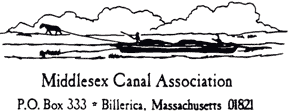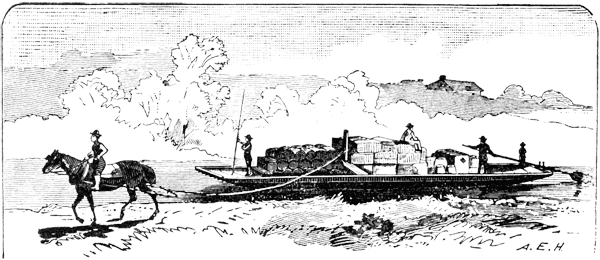


Middlesex Canal Association P.O. Box
333 Billerica, Massachusetts 01821
Volume 37, No.1 September, 1998
MIDDLESEX CANAL ASSOCIATION
LOWELL NATIONAL HISTORICAL PARK
MIDDLESEX CANAL DAY
Sunday, September 27, 12:30-5 pm
This year we will join for our fall outing with the Lowell National Historical Park's Canal Heritage Weekend. On Sunday, September 27, the LNHP, in association with the MCA, is offering a program of a talk by MCA President Nolan Jones at 12:30 pm, followed by a bus tour along the Canal route from the Merrimac River to North Billerica This will include Middlesex Village, the future home of the Middlesex Canal Museum.
Meet at the LNHP Visitor Center on Thorndike Street in Lowell. From Rte 3, take the Lowell Connector to exit 5B, Thorndike Street, and the Visitor Center parking lot. For more information, contact the LNHP Visitor Center at 978-970-5000, or Roger Hagopian at 781-861-7868.
FALL MEETING
BOATS AND BOATING ON THE MIDDLESEX CANAL
Date: Sunday, November 1, 1998
Time: 2:30 pm
Place: Auditorium of the Winchester Hospital unit at 12 Alfred Street, Woburn (directly opposite the Baldwin Mansion Restaurant at the intersection of Rte. 128 and Rte. 38).
The boats that plied the Middlesex Canal and the boating companies that operated most of them are the focus of the sixth annual event in celebration of the Canal's Bicentennial Decade celebration on November 1. A special feature will be an account of the design, construction and summertime cruises of the Colonel Baldwin, a replica of a typical canal packet boat built in 1976 and which will be displayed in Kiwanis Park, adjacent to the Baldwin Mansion, as a permanent exhibit.
Dave Dettinger, a Proprietor and Director of the Middlesex Canal Association, will describe the various boats used on the Canal throughout its years of operation, drawing on historical records. The emergence of boating companies geared to the daily operation of barges and packets will be addressed, along with the rules that evolved to handle traffic on the Canal.
Len Harmon, a founder of the Woburn Canal Society and an Honorary Director of the Middlesex Canal Association, will recount his central role in researching the dimensions, structure and appearance of a packet boat intended to carry passengers, and his design of a replica. He will describe the construction process and the final decoration of the boat. Finally, he will offer an entertaining account of operating the packet for several years to carry visitors along the watered segment of the Canal beside the Baldwin Mansion.
The public is cordially invited to attend this program.
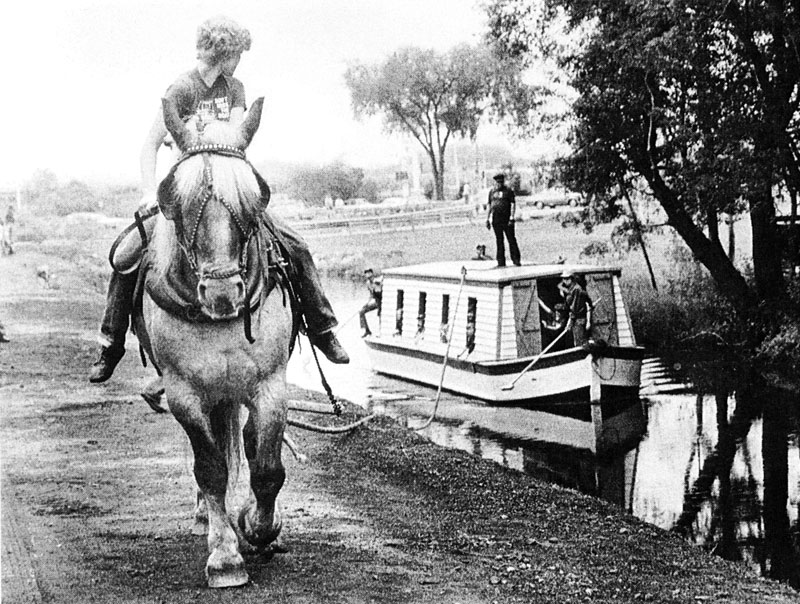
The replica packet boat built to operate near the Baldwin Mansion. Construction started in December 1975,
completed and floated in the spring of 1976. Operated for tours from 1977-1981. 1977 photo.
PRESIDENT'S MESSAGE
The federal money has come through for the Middlesex Canal Commission's planned design of the park at the North Billerica Mill Pond and the contract is being signed. We have received a grant from the Massachusetts Historical Commission and we are about to sign a contract with a consultant to prepare for submission of the rest of the Middlesex Canal to the National Registry of Historic Places. So positive steps are being taken to preserve the remnants of our Canal.
Meanwhile, a golf driving range is being built over the path of the Canal in Wilmington near the Woburn line. Last year two houses were built on the towpath on Middlesex Street in Woburn. The legislation that set up the Middlesex Canal Commission requires that the Commission be notified when proposed construction is presented to Planning Boards or other town agencies. Sometimes this happens, but many times it does not. We need to be alert to such threats.
The British canalers will be visiting the Baldwin Restaurant on September 18, as mentioned in the last Towpath Topics. Hugh Potter, editor of Waterways World, joined us for our Fall 1997 Canal walk. He is in the photo of that event in the last Towpath Topics.
When you read this, Joan and I will be in a narrow boat cruising on the Leeds to Liverpool Canal in northern England with the Canal Society of New Jersey. We return on September 21.
We have one "outside" talk scheduled, with the Acton Historical Society on November 15. I make a practice of accepting all requests in the effort to publicize our Canal and our Association.
| 1998 August 24 | Nolan T. Jones, President |
SPRING WALK - 1998
by Roger Hagopian
This past spring, the Middlesex Canal Association conducted its walk in two sections of Woburn - south of Route 128 (Interstate 95) to Winn Street near Woburn Center, and north of 128 from the Baldwin Mansion (Restaurant) to beyond North Woburn (School Street).
We began our walk at Middlesex Canal Drive, behind the Woburn Cinemas. At this point the bed of the Canal is partially occupied by the abandoned roadbed embankment of the Woburn branch of the Boston and Maine Railroad (1885-1961). Ironically, the railroad, which displaced the Canal, inadvertently saved the Canal right of way from development for over 100 years after the Canal's demise. Eventually the roadbed moves onto the towpath east of the Canal, which for mile assumes its original width of approximately 30 feet. At Kilby Street the Canal route deviates from the railroad and our group walked about 300-400 feet up Kilby Street to observe the site of the 15-20-foot deep cut there, now filled in.
With the reactivation of the Middlesex Canal Commission under MCA board member Tom Raphael, our walks are no longer just a visit into the past, but a look at the future through historic preservation. In our previous walk through Chelmsford, we encountered one example of "growing pains" as we strive to achieve the goal of a viable Canal and towpath trail (see Towpath Topics, Spring 1998).
Upon our group's arrival at Winn Street we were treated to an example of the ongoing war between development and preservation. The Canal bed, which had been intact before the winter of 1996-97, had been filled in and was now occupied by two or three newly built colonial houses. Here was located a Canal basin 50-60 feet wide and stop gates. The gatekeeper's house from the early 1800s survives, but for how long?
The second portion of our walk followed the Canal north from Baldwin's along a half-mile stretch restored during our nation's bicentennial. The 1790 house, the mansion of Count Rumford, friend of the Canal engineer Loammi Baldwin, has been moved sideways and closer to the Canal. But what of the watered basin which led to the rear of the mansion, once the landing point for the guests of Rumford? Will it be spared?
We spontaneously took our group beyond School Street, where the Canal route to the Wilmington border is a puzzle with many missing pieces. Through the woods we hiked, clinging to any signs of the dry bed or towpath and berm. Upon reaching a home built right on the Canal route, we introduced ourselves to the owner, who happened to be outside. He had bought the house long after it was built there, and, being from Virginia, was very aware of the preservation battle for Civil War sites, as well as George Washington's farm. He had even landscaped the portion of towpath which passed through his yard. So there is hope!
As stated before, our walks will examine what is lost forever, what remains, and the potential for preservation and restoration of the Middlesex Canal.
REPORT ON THE INCREDIBLE DITCH
by Carl Seaburg
This is a first report to the members of the Middlesex Canal Association and all the friends of the Middlesex Canal on how its latest history, The Incredible Ditch, by Carl Seaburg, Alan Seaburg and Tom Dahill, is faring with the reading public.
First the reviews; they have been good. The Boston Globe hailed it as the "definitive history of this economic and engineering milestone," while Dr. Valentin Rabe, Professor of American History Emeritus, University of Hull, praised the volume's excellent use of original sources and its ability to convey "technical information clearly."
Next the sales; they have been constant and steady. By mid-summer almost 500 copies have been sold. The Incredible Ditch is currently in stock and available at several area bookstores, including Waterstone's and Barnes & Noble in the Burlington Mall, the Museum Store in Lowell, Wordsworth in Harvard Square, the Concord Bookshop, the Tufts University Bookstore (run by Barnes & Noble), the Bestsellers Cafe in Medford Square, and Book Ends in Winchester Square.
Please remember that once the printing costs have been met, all the profits from the Ditch go equally to the Middlesex Canal Association and the Medford Historical Society. Please keep this beautiful and informative book in mind for holiday giving!
To order your copy by mail, send $30.00 for the book plus $2.50 P&H to:
| Medford Historical Society 10 Governors Avenue Medford, MA 02155 |
Carl Seaburg can be reached at 978-670-0876.
WINCHESTER CANAL STONES RETRIEVED
by Tom Raphael
Approximately 120 of the stones from the Symmes (Aberjona) River aqueduct of the old Middlesex Canal, scattered in the Winchester Town Forest and adjacent Briarwood Lane development, have been retrieved and transported to a storage yard of the Boston Tree Company in Woburn.
The photographs show the stones, measuring 18 x 18 in. by 8 ft., and weighing about 3 tons, being lifted by an "excavator" from the woods onto a truck for transport, and in their current holding area. For more background information, see reference (4) in the article on the Brooks estate elsewhere in this issue.
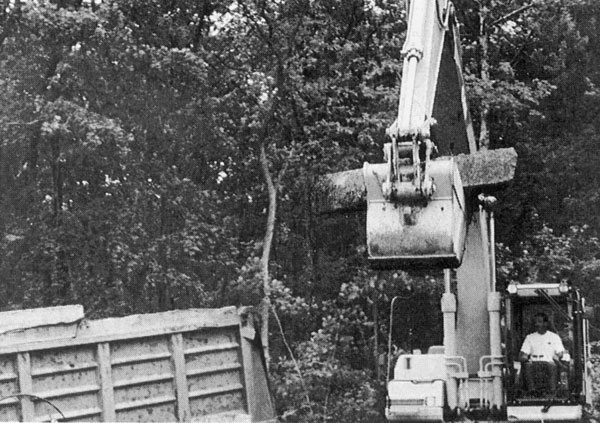
Canal stone from the Symmes (Aberjona) River aqueduct being loaded for transportation to storage.
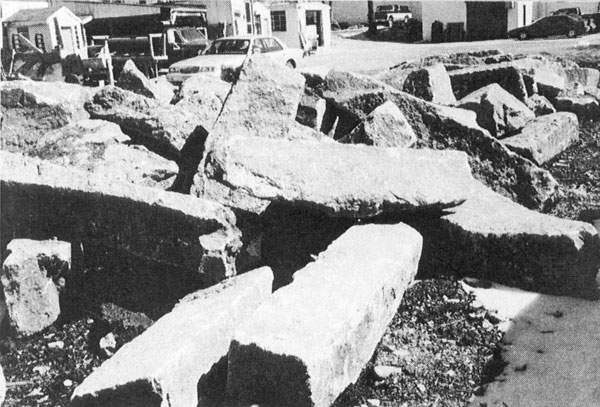
Boston Tree Company's Draper Street Yard in Woburn showing storage of the recovered Canal stones. (Photos by Thomas Raphael)
MIDDLE SAXON
by Howard B. Winkler
The Middlesex Canal is located in its entirety within the original boundaries of Middlesex County. I have often wondered about the origin of the word Middlesex, and have come to learn that means the territory of the Middle Saxons, originally a tribal name from Old English: middel + Seaxe. The earliest occurrence of the word Middleseaxan is in 704. It also appears in the Domesday Book, 1086.
Middlesex is a former county of south western England situated north of London. In 1965 it was divided up between Hertfordshire and Greater London. The name of the county arose from its location between the lands of the East Saxons (Essex) and West Saxons (Wessex). The Massachusetts county may have been named, in part, due to its central location in the New England colony.
The US Geodetic Survey's Gazetteer internet site indicates 57 occurrences of Middlesex as the name of churches, dams, mines, population places, schools, etc. The population places include three other counties which also have this name and are to be found in Connecticut, New Jersey and Virginia. All of the named places, except for two, are to be found in 10 of the original 13 colonies. The two that are not included are names of mines located in Colorado and Nevada. It may be that the mines were funded by banks in states that were once colonies, and the investors provided both the money and the name.
A check for the name Middlesex on PhoneDisk 98, a telephone directory on compact disk, which includes all 50 States and the District of Columbia, indicates 518 occurrences under Business and two under Residence. Of the 520 total occurrences, 515 are east of the Mississippi, and all but one are to be found in the states and their territories that comprised 12 of the 13 colonies. The exception is Florida. The most frequent use of the name is in New Jersey where there are to be found 182 occurrences. Massachusetts is runner up with 176.
Because of sexual suggestions, the name Middlesex has never became popular according to one reference, and a California community changed its name in 1955 for this reason.
Bibliography
American Place Names, George R. Stewart. 1970.
A Dictionary of English Place Names, A. D. Mills, 1991.
Columbia Gazetteer of the World, c. 1998.
Illustrated Dictionary of Place Names, United States and Canada, ed. Kelsie B. Harder, 1976.
Oxford Dictionary of the World, ed. David Munro, 1995.
BROOKS ESTATE DEDICATION
by Thomas Raphael
[Note: the author is a Proprietor and Director of the Middlesex Canal Association, as well as being Chair of the Executive Committee of the Middlesex Canal Commission.]
On Saturday May 2, 1998, 50 acres of the old Brooks Estate in Medford were formally dedicated and protected with a Conservation and Preservation Restriction.
The Brooks family first settled in Medford in 1660, when Thomas Brooks purchased 400 acres of woods and farm. The family holdings were divided among descendants, who built homes and farmed adjacent to each other. The family was one of the most prominent in Medford and was heavily involved in the civic life.
John Brooks, the Second Vice-President of the Middlesex Canal Company, served as Governor from 1816 to 1822. Serving as his Lieutenant Governor was his relative Peter Chardon Brooks, through whose property the Middlesex Canal passed (1). In the mid-nineteenth century, after the canal was abandoned and the Mystic aqueduct was dynamited, a large number of the granite "stones" from the aqueduct were transported (2,3,4) to the Brooks properties.
Shepherd Brooks was born in 1837. With the premature death of his father, he inherited significant assets before his graduation with an architects degree from Harvard in 1857. He married Clara Gardner, niece of Isabella Stewart Gardner, in 1872.
In 1859 Peter Chardon Brooks III built a summer home at the highest point of the property, the Point of Rocks. Shepherd Brooks built Acorn Hill (the Manor) in 1880. Both families lived most of the year in Boston, but summered in Medford, then a farming community.
The design of his summer estate was a large part of Shepherd's life work. With a background in architecture and agriculture, he set out to re-shape his farm. First he hired the prestigious firm of Peabody and Stearns to design the Shepherd Brooks Manor and Carriage House (stable) in 1880. He then transformed the landscape by creating Brooks Pond (1884-89) and cutting vistas to it.
The Shepherd Brooks Manor is in the Queen Ann style, characterized by elements of classical architecture: a steep pitched roof and detailed chimneys. The primary exterior material is red brick, with brownstone sills and trim. The house has a granite foundation (with stones recycled from the Middlesex Canal) and a slate roof with copper flashing.
The house is organized around a large central hall that runs the length of the house, separating an elegant parlor and library on one side from an office and dining room on the other. A beautiful carved butternut staircase dominates the hall.
The Manor is designed so that each face is different and responds differently to the surroundings. The west elevation (back of the house) faced all the way across the property to the Point of Rocks. The most familiar view extended from the south veranda to Brooks Pond, or Slow Pond, which is the most significant man-made landscape introduced into Medford.
Originally a marsh, the area used a steam engine and centrifugal pump to drain water from the marsh into a small canal running south, and 76,000 loads of muck were removed by hand. A dam to maintain the ponds at a desirable level was constructed of granite stones from the Middlesex Canal. A Gothic farm house, as a caretaker's residence at 3 Apache Trail, was built by Peter Chardon Brooks III from granite ashlars also from the Canal aqueduct.
Medford began a dramatic transformation from a rural community to a suburban city in the first two decades of the 20th century. This process was well advanced by the time Shepherd died in 1922; his wife Clara Gardner Brooks worked to protect the property from development, but in 1939 when she died her plans fell through.
In 1941, 28 acres were sold to Winchester at a fraction of the value, where the parcel is maintained as the Brooks-Parkhurst Town Forest. Scattered about the forest and adjacent private property are about 265 of the Middlesex Canal aqueduct's stones (4).
In 1942, the City of Medford acquired the remaining 82 acres of the Brooks Estate and demolished the Point of Rocks in 1946. From 1946 to the 1970s, the Manor was used to house families, as a nursing home and more recently as a home for mentally challenged adults. It is now occupied by a caretaker.
Now, in 1998, after four years of advocacy and negotiations, the Brooks Estate has been permanently protected. The challenge will be to care for the grounds and restore the Shepherd Brooks Manor and Carriage House.
[Note: Thomas Lincoln, President of the Brooks Estate Preservation Association, is also the Middlesex Canal Commission's Vice-Chair and Medford's representative.]
References:
1. The Brooks Bridge, Towpath Topics, Vol. 1, p.1.
2. Winchester Canal Stones, ibid, Vol. 32, No. 1, pp. 10-11.
3. More on the Canal Stones, ibid, Vol 33, No. 1, pp 6-7.
4. Canal Stones Preserved, ibid, Vol. 36, No. 2, p.8; see also photos elsewhere in this issue.
For more information or contributions, contact:
The Brooks Estate Preservation Association (BEPA)
P.O. Box 522
Medford, MA 02155
tel: 781/396-3001
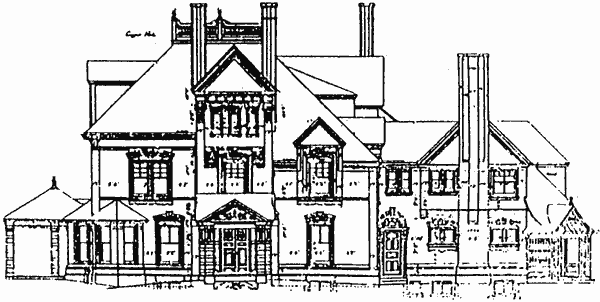
Architect 's drawing - west elevation of the Shepherd Brooks Manor
MORE ON THE ERIE CANAL PARK
AT CAMILLUS, NEW YORK
by Dave Dettinger
In the last issue of Towpath Topics, Alan Seaburg contributed an article about the Erie Canal Park at Camillus, New York, which he had recently visited. Reading his account brought back to me a recollection of a visit there in 1983.
At that time a group of ten Middlesex Canal Association members joined with the New Jersey Canal Society in a tour of the eastern portion of the Erie Canal. The group included Nolan Jones, Marion Potter, Burt and Fran VerPlanck and myself, among others. On the evening of June 30 we left our Syracuse motel and bussed to Camillus. There we met the enthusiastic volunteers who had developed the Park, walked along the remains of "Clinton's Folly," viewed the aqueduct and other features, and returned on their tour boat via the enlarged Erie Canal, reconstructed in the mid-19th century. Like Alan, we were impressed with the work and dedication of the local volunteers and encourage anyone who visits the area to include a tour of the Camillus Erie Canal Park.
